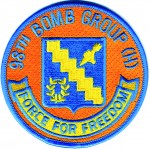History
98th Bomb Wing (M): 1947 to 1954. B-29s
The 98th was reactivated on 1 July 1947 and equipped with B-29 Superfortresses at Spokane Army Airfield, Spokane, Washington. In 1948, the wing deployed to Okinawa for 90 days. During this period, the 98th lost two B-29s and a C-54 that was forced to ditch in the Pacific Ocean while returning 98th personnel to the U.S. Another 90-day rotation to Scultorp, England, was conducted in the summer of 1949.
While deployed to the U. K., the aircrews practiced high level (35,000 ft.) bombing missions on the Dutch island of Helgoland and conducted defensive tactics against RAF and USAF fighters. The gunners were evaluated using gun camera film, and the bombardiers were scored by the distance from the target that their bombs impacted. All crewmembers were evaluated on the skills and knowledge required to accomplish their assigned duties.
Needless to say, none of the missions could have been successful without the support of the ground personnel. All the wing’s activities were conducted under simulated wartime conditions and placed additional demands on everyone--from top to bottom. For example, the food service personnel did an unbelievable job in making dehydrated potatoes, powdered eggs, bully beef, turnip soup, month-old bread and Spam palatable. Thanks to the outstanding efforts of everyone, the 98th received very high ratings in all phases of the evaluation and was declared combat ready.
Sadly, during the two-and-one-half month training phase into the new bomber, the 98th suffered the loss of six B-29s and the deaths of several aircrew members.
In early 1950, the 98th was alerted for a permanent change of station to Ramey AFB, Puerto Rico. However, before the move was completed, the Korean conflict broke out, and the wing was deployed to Yokota Air Base, Japan. The unit arrived in Japan the first week of August 1950 and flew its first combat mission on August 7th. Although the 98th was designated a wing, it continued to operate as a group until 1951, when it was fully staffed as a wing.
The 98th continued to fly bombing missions against the Communists in Korea until the ceasefire in 1953. From August 1950 to July 1953, the wing flew more than 5,000 sorties and dropped more than 40,000 tons of bombs (actual total unavailable). The 98th earned 10 battle streamers and 2 Outstanding Unit Awards comparable to the Presidential Unit Citations. The wing also was awarded the South Korean Presidential Citation. The 98th was credited with the destruction of 5 MIG-15 jet fighters and 1 propeller driven fighter. The wing suffered the loss of 19 B-29s between August 1950 and July 1953.
Following the cessation of combat during the Korean War, the wing remained at Yokota to help ensure the enemy observed ceasefire conditions. The wing started its return to the U.S. in July 1954. Selected aircrews flew the B-29s to Davis-Monthan AFB, where the planes were deposited at the “Boneyard.”
